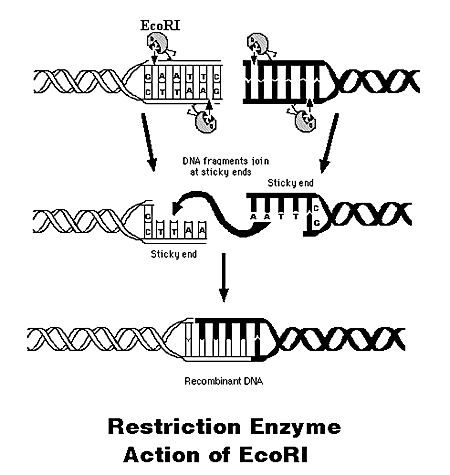 Click here for an animation that explains how restriction enzymes cut DNA.
Click here for an animation that explains how restriction enzymes cut DNA.Still confused? Think of it this way: our bodies naturally produce restriction enzymes. We call them digestive enzymes, like amylase, trypsin, pepsin, protease, lipase, etc. These enzymes are not effective to cut DNA for genetic engineering purposes because they cut DNA randomly. That's why scientists rely on restriction enzymes produced by bacteria. These enzymes can cut DNA at precise locations.
A restriction enzyme recognizes and cuts DNA only at a particular sequence of nucleotides. For example, the bacterium Hemophilus aegypticus produces an enzyme named HaeIII that cuts DNA wherever it encounters the sequence
5'GGCC3'
3'CCGG5'
The cut is made between the adjacent G and C. HaeIII cuts straight across the double helix producing "blunt" ends. However, many restriction enzymes cut in an offset manner (like HIND III that we used during the gene splicing simulation). The ends of the cut have an overhanging piece of single-stranded DNA. These are called "sticky ends" because they are able to form base pairs with any DNA molecule that contains the complementary sticky end. Any other source of DNA treated with the same enzyme will produce the same cuts.
Mixed together, these molecules can join with each other by base pairing between their sticky ends. The two DNA molecules can be joined by another enzyme, DNA ligase. The result is a molecule of recombinant DNA (rDNA).
The ability to produce recombinant DNA molecules has allowed geneticists to produce human insulin (for diabetics), human factor VIII (for males with hemophilia A), and other proteins used in human therapy all were made possible by recombinant DNA.
If the restriction enzymes recognize the DNA sequence, then they also have to recognize the complementary DNA sequence, right?
ReplyDeleteThis animation was really helpful Leslie!
Cool!
ReplyDeleteBut if scientists could do that, then why can't they just disrupt virus dna like HIV to mess up its system? It would eventually stop mutating and the body could find the right antibody and kill the HIV! Right? I think... Could someone answer that?
And why can't we just take stimulants to stimulate the pancreas to make more insulin rather than taking insulin itself? You can answer this too....
And I'm also wondering... can scientists stimulate certain parts of the DNA to be read?Like making a muscle cell create proteins created by other cells? Ex: skin cells
That could also rush puberty and stuff like that...
Michael N. 7I
Just saying but, these animations are so cool!
ReplyDeleteCould WE create one ourselves on something we learn this year? Like the book that we had to do on cellular respiration?
Michael N.
so the retriction enzymes "cut" or "separate" DNA nucleotides?
ReplyDeletewhere did restrictions enzymes get there name?
ReplyDeleteI Never really understood how restriction enzymes worked with how they knew what to cut and what to leave alone~! The animation helped me visualize how a restriction enzyme workes!
ReplyDelete~Peter The Great 7E
It really fascinates me that scientists can retrieve this information about micro-sized bits and then simplify it down enough to make it a detailed animation for the world to understand easier. Thank you for the post, Leslie, it was fun to watch!!!
ReplyDeletebut how do scientists figure out what restriction enzyme to use? i mean, they use them to figure out the sequence of bases, kind of, with dna electrophoresis, so how do they figure out which one to use?
ReplyDeletei knew how it worked already but this just further helped me understand them.
ReplyDelete-Gordon Yang
Really cool! How many types of restriction enzymes are there? Overall really interesting though!
ReplyDeleteHow exactly do the enzymes cut the DNA?
ReplyDeleteThis helped me so much!
ReplyDeleteThanks Leslie!